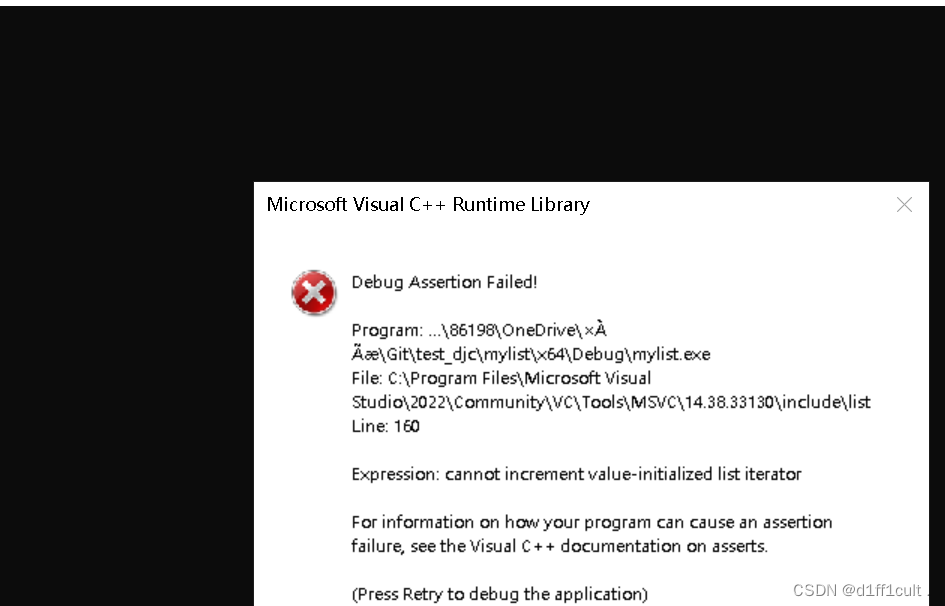目录
1.list的使用
1.1list的定义
1.2list的使用
1.3list iterator使用
1.4list capacity
1.5list element access
1.6list增删查改
2.list迭代器失效问题
3.list的模拟实现
1.list的使用
1.1list的定义

1. list是可以在常数范围内在任意位置进行插入和删除的序列式容器,并且该容器可以前后双向迭代。
2. list的底层是双向链表结构,双向链表中每个元素存储在互不相关的独立节点中,在节点中通过指针指向其前一个元素和后一个元素。
3. list与forward_list非常相似:最主要的不同在于forward_list是单链表,只能朝前迭代,已让其更简单高效。
4. 与其他的序列式容器相比(array,vector,deque),list通常在任意位置进行插入、移除元素的执行效率更好。
5. 与其他序列式容器相比,list和forward_list最大的缺陷是不支持任意位置的随机访问,比如:要访问list的第6个元素,必须从已知的位置(比如头部或者尾部)迭代到该位置,在这段位置上迭代需要线性的时间开销;list还需要一些额外的空间,以保存每个节点的相关联信息(对于存储类型较小元素的大list来说这可能是一个重要的因素)
1.2list的使用
| 构造函数 | 结构说明 |
| list(size_type n,const value_type& val=value_type()) | 构造的list中包含n个值为val的元素 |
| list() | 构造空的list |
| list(const list&x) | 拷贝构造函数 |
| list(InputIterator first,InputIterator last) | 用[first,last)区间中的元素构造list |
1.3list iterator使用
| 函数声明 | 接口声明 |
| begin+end | 返回第一个元素的迭代器+返回最后一个元素的下一个位置的迭代器 |
| rbegin+rend | 返回第一个元素reverse_iterator,即end的位置+返回最后一个元素下一个位置的reverse_iterator,即begin的位置 |
需要注意的是:
1.begin与end为正向迭代器,对迭代器执行++操作,迭代器向后移动
2.rbegin(end)与rend(begin)为反向迭代器,对迭代器执行++操作,迭代器向前移动
1.4list capacity
| 函数声明 | 接口说明 |
| empty | 检查list是否为空,为空返回true,不为空返回false |
| size | 返回list中有效节点的个数 |
1.5list element access
| 函数声明 | 接口说明 |
| front | 返回list的第一个节点中值的引用 |
| back | 返回list的最后一个节点中值的引用 |
1.6list增删查改
| 函数声明 | 接口声明 |
| push_front | 在list首元素前插入值为val的元素 |
| pop_front | 删除list中第一个元素 |
| push_back | 在list尾部插入值为val的元素 |
| pop_back | 删除list中最后一个元素 |
| insert | 在list position位置中插入值为val的元素 |
| erase | 删除list position位置的元素 |
| swap | 交换两个list中的元素 |
| clear | 清空list中的有效元素 |
2.list迭代器失效问题
与string和vector相似,list的迭代器也会出现失效的问题
#include<iostream>
#include<list>
using namespace std;
int main()
{int array[] = { 1, 2, 3, 4, 5, 6, 7, 8, 9, 0 };list<int> l(array, array + sizeof(array) / sizeof(array[0]));auto it = l.begin();while (it != l.end()){l.erase(it);++it;}
}

下面是正确的使用方式,每次都更正一下迭代器it指向的结点位置。
void TestListIterator()
{
int array[] = { 1, 2, 3, 4, 5, 6, 7, 8, 9, 0 };
list<int> l(array, array+sizeof(array)/sizeof(array[0]));
auto it = l.begin();
while (it != l.end())
{
l.erase(it++); // it = l.erase(it);
}
}3.list的模拟实现
#pragma once
#include<assert.h>namespace mylist
{template<class T>struct ListNode{ListNode<T>* _next;ListNode<T>* _prev;T _data;ListNode(const T& x = T()):_next(nullptr),_prev(nullptr),_data(x){}};template<class T>struct __list_iterator{typedef ListNode<T> Node;typedef __list_iterator<T> self;Node* _node;__list_iterator(Node* x):_node(x){}// ++itself& operator++(){_node = _node->_next;return *this;}// it++self operator++(int){//__list_iterator<T> tmp(*this);self tmp(*this);_node = _node->_next;return tmp;}self& operator--(){_node = _node->_prev;return *this;}self operator--(int);T& operator*(){return _node->_data;}bool operator!=(const self& s){return _node != s._node;}bool operator==(const self& s);};template<class T>class list{typedef ListNode<T> Node;public:typedef __list_iterator<T> iterator;iterator begin(){//return iterator(_head->_next);return _head->_next;}iterator end(){return _head;}void empty_init(){_head = new Node;_head->_next = _head;_head->_prev = _head;}list(){empty_init();}void clear(){iterator it = begin();while (it != end()){it = erase(it);}}~list(){clear();delete _head;_head = nullptr;}//list(const list<T>& lt)list(list<T>& lt){empty_init();for (const auto& e : lt){push_back(e);}}// lt1 = lt2;// list<T>& operator=(const list<T>& lt)/*list<T>& operator=(list<T>& lt){if (this != <){clear();for (const auto& e : lt){push_back(e);}}return *this;}*/void swap(list<T>& tmp){std::swap(_head, tmp._head);}//list& operator=(list lt)list<T>& operator=(list<T> lt){swap(lt);return *this;}void push_back(const T& x){/*Node* newnode = new Node(x);Node* tail = _head->_prev;tail->_next = newnode;newnode->_prev = tail;newnode->_next = _head;_head->_prev = newnode;*/insert(end(), x);}void push_front(const T& x){insert(begin(), x);}void pop_back(){erase(--end());}void pop_front(){erase(begin());}// vector insert会导致迭代器失效// list会不会?不会iterator insert(iterator pos, const T& x){Node* cur = pos._node;Node* prev = cur->_prev;Node* newnode = new Node(x);// prev newnode curprev->_next = newnode;newnode->_prev = prev;newnode->_next = cur;cur->_prev = newnode;//return iterator(newnode);return newnode;}iterator erase(iterator pos){assert(pos != end());Node* cur = pos._node;Node* prev = cur->_prev;Node* next = cur->_next;prev->_next = next;next->_prev = prev;delete cur;return next;}private:Node* _head;};void test_list1(){list<int> lt;lt.push_back(1);lt.push_back(2);lt.push_back(3);lt.push_back(4);list<int>::iterator it = lt.begin();while (it != lt.end()){//*it += 10;cout << *it << " ";++it;}cout << endl;for (auto e : lt){cout << e << " ";}cout << endl;}void test_list2(){list<int> lt;lt.push_back(1);lt.push_back(2);lt.push_back(3);lt.push_back(4);for (auto e : lt){cout << e << " ";}cout << endl;lt.push_back(5);lt.push_front(0);for (auto e : lt){cout << e << " ";}cout << endl;lt.pop_back();lt.pop_front();for (auto e : lt){cout << e << " ";}cout << endl;lt.clear();for (auto e : lt){cout << e << " ";}cout << endl;lt.push_back(10);lt.push_back(20);for (auto e : lt){cout << e << " ";}cout << endl;}void test_list3(){list<int> lt;lt.push_back(1);lt.push_back(2);lt.push_back(3);lt.push_back(4);for (auto e : lt){cout << e << " ";}cout << endl;list<int> copy(lt);for (auto e : copy){cout << e << " ";}cout << endl;list<int> lt1;lt1.push_back(10);lt1.push_back(20);lt1.push_back(30);lt1.push_back(40);lt = lt1;for (auto e : copy){cout << e << " ";}cout << endl;}
}4.list和vector的对比
| vector | list | |
| 底层结构 | 动态顺序表,一段连续空间 | 带头结点的双向循环链表 |
| 随机访问 | 支持随机访问,访问某个元素效率O(1) | 不支持随机访问,访问某个元素效率O(N) |
| 插入和删除 | 任意位置插入和删除效率低,需要搬移元素时间复杂度为O(N),插入时有可能需要增容,增容:开辟新空间,拷贝元素,释放旧空间,会导致效率降低, | 任意位置插入和删除效率高,不需要搬移元素,时间复杂度为O(1); |
| 空间利用率 | 底层为连续空间,不容易造成内存碎片,空间利用率高,缓存利用率高 | 底层节点动态开辟,小节点容易造成内存碎片,空间利用率低,缓存利用率低 |
| 迭代器 | 原生指针 | 对原生指针(节点指针)进行封装 |
| 迭代器失效 | 在插入元素时,要给所有的迭代器重新赋值,因为插入元素有可能会导致重新扩容,致使原来迭代器失效,删除时,当前迭代器需要重新赋值否则会失效 | 插入元素不会导致迭代器失效,删除元素时,只会导致当前迭代器失效,其他迭代器不受影响 |
| 使用场景 | 需要高效存储,支持随机访问,不关心插入删除效率 | 大量插入和删除操作,不关心随机访问 |




)

)


问题解决)









